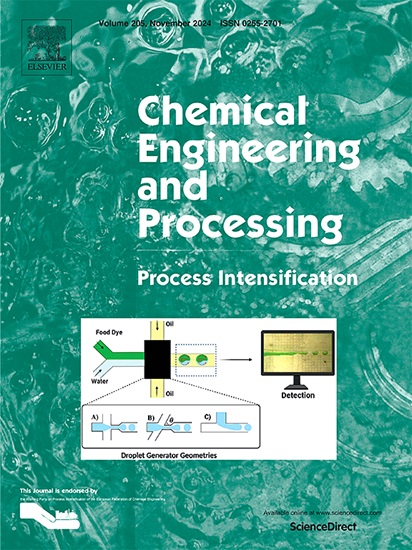Investigation of the limits of unconventional ammonia synthesis
IF 3.8
3区 工程技术
Q3 ENERGY & FUELS
Chemical Engineering and Processing - Process Intensification
Pub Date : 2025-07-01
DOI:10.1016/j.cep.2025.110429
引用次数: 0
Abstract
Intensified NH3 synthesis is modeled in a Fe-based catalyst-coated, in-situ cooled microchannel reactor (MR) comprising a ZnCl2-IMS (Immobilized Molten Salt) membrane. NH3 produced in the reaction (R) channel is separated to the neighboring permeate (P) channel hosting sweep N2 flow that regulates temperature to <623 K. A low-cost model is formulated and successfully benchmarked with the comprehensive counterpart and experimental data. MR configurations are modeled to elucidate the effects of catalytic activity, NH3 permeance, sweep gas-to-reactive stream ratio (SR), and flow partitioning on the interplay between NH3 production, separation, and heat transfer. At 613 K, 50 bar, H2/N2 = 3 and 1.5 × 10–3 m3 kgcat-1 s-1, the 47.4 % N2 conversion exceeds the equilibrium limit (42 %) and the membraneless counterpart (14 %). Under identical conditions, a two-fold increase in the reaction rate and NH3 permeance gives 91 % N2 conversion. Increasing SR promotes N2 conversion and NH3 recovery, but decreases NH3 fraction in the P channel, a metric for the post-NH3 separation by a secondary membrane separator. While co-current dosing to the R and P channels offers slightly higher N2 conversions, the identically operated counter-current mode gives higher NH3 recovery. The findings provide guidelines for the opportunities and limitations of the membrane-separation driven NH3 synthesis.

非常规氨合成极限的研究
在含ZnCl2-IMS(固定化熔盐)膜的铁基催化剂包覆原位冷却微通道反应器(MR)中模拟了NH3的强化合成。反应(R)通道中产生的NH3被分离到邻近的渗透(P)通道中,渗透(P)通道承载扫描N2流,将温度调节到623 K。建立了一个低成本的模型,并成功地通过综合对比和实验数据进行了基准测试。模拟MR构型以阐明催化活性、NH3渗透率、扫气-反应流比(SR)和流动分配对NH3产生、分离和传热之间相互作用的影响。在613 K, 50 bar, H2/N2 = 3和1.5 × 10-3 m3 kgcat-1 s-1条件下,47.4%的N2转化率超过平衡极限(42%)和无膜对应(14%)。在相同条件下,反应速率和NH3渗透率增加两倍,N2转化率达到91%。提高SR可以促进N2转化和NH3的回收,但降低了P通道中NH3的分数,P通道是二次膜分离器后NH3分离的一个指标。虽然R和P通道的共电流剂量提供略高的N2转化率,但相同操作的逆流模式提供更高的NH3回收率。这些发现为膜分离驱动NH3合成的机会和局限性提供了指导。
本文章由计算机程序翻译,如有差异,请以英文原文为准。
求助全文
约1分钟内获得全文
求助全文
来源期刊
CiteScore
7.80
自引率
9.30%
发文量
408
审稿时长
49 days
期刊介绍:
Chemical Engineering and Processing: Process Intensification is intended for practicing researchers in industry and academia, working in the field of Process Engineering and related to the subject of Process Intensification.Articles published in the Journal demonstrate how novel discoveries, developments and theories in the field of Process Engineering and in particular Process Intensification may be used for analysis and design of innovative equipment and processing methods with substantially improved sustainability, efficiency and environmental performance.

 求助内容:
求助内容: 应助结果提醒方式:
应助结果提醒方式:


